Shipyard named after 61 communard. Battleship "Three Saints"
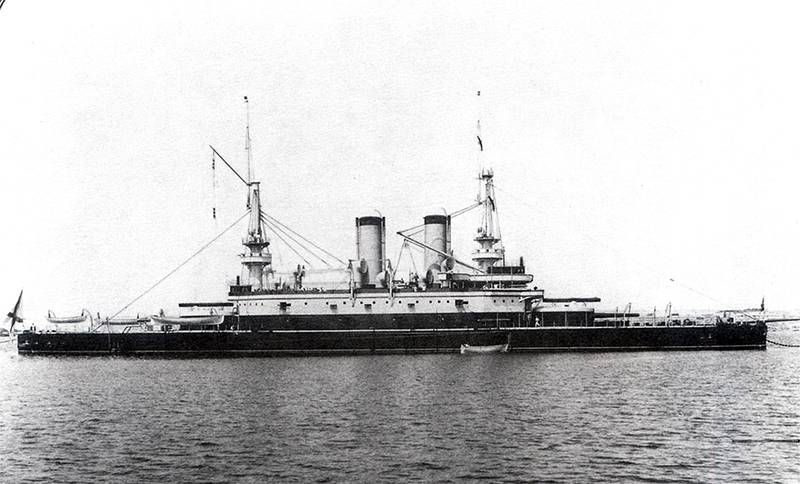
With the death of the head of the naval ministry, Admiral Shestakov, the period of experimentation with small universal armadillos ended. The ships really had a relatively small displacement, but could hardly be classified as universal. At the last of them, the Black Sea "Twelve Apostles", the shortcomings of the whole concept were clearly expressed: possessing better seaworthiness than the ships of the "Catherine II" type, he had weaker weapons and a reservation. In addition, the possibilities for further modernization of the "Twelve Apostles" were exhausted due to the complete lack of stock displacement. However, soon in Russia, in particular, in the Nikolaevskiy Admiralty, they began the construction of classic battleships, the first of which was the Navarin in the Baltic, and the Three Saints on the Black Sea.
New ideas. New ships
At the last stage of his service as head of the Maritime Ministry, despite obvious technical difficulties and ongoing debates, Admiral Shestakov continued to brood the idea of “small and small-sized” battleships. To create the next of them, it was decided to attract the Franco-Russian plant, which was considered well-equipped. In February, 1888, Chief Engineer of the Society of Franco-Russian Plants, engineer P.C. Du Bouy presented for review the draft of the battleship with a displacement of 6500 tons, which fully complied with the idea of "small and small."
While this project was being considered, the Main Marine Headquarters received information on the construction of Brandenburg-type battleships in Germany. These ships, with a displacement of 10,5 in thous. Tons, developed speeds up to 16 nodes and were armed with six 280-mm guns in three towers. Of course, all economy-class ships that were built on the ideas of Admiral Shestakov looked on this background somewhat uncertainly.
It was decided to completely redo the project of the Franco-Russian plant. Displacement from 6500 tons raised to 8900 tons. It was planned to arm the future ship with four 305-mm guns in the towers and four 152-mm guns in the casemates. Solid armor belt reached the thickness of mm 406 and mm 203 in the extremities. Subsequently, the Marine Technical Committee made amendments and changes to these characteristics. The number of 152-mm guns doubled, strengthened the booking of casemates, and the displacement increased to 9500 tons.
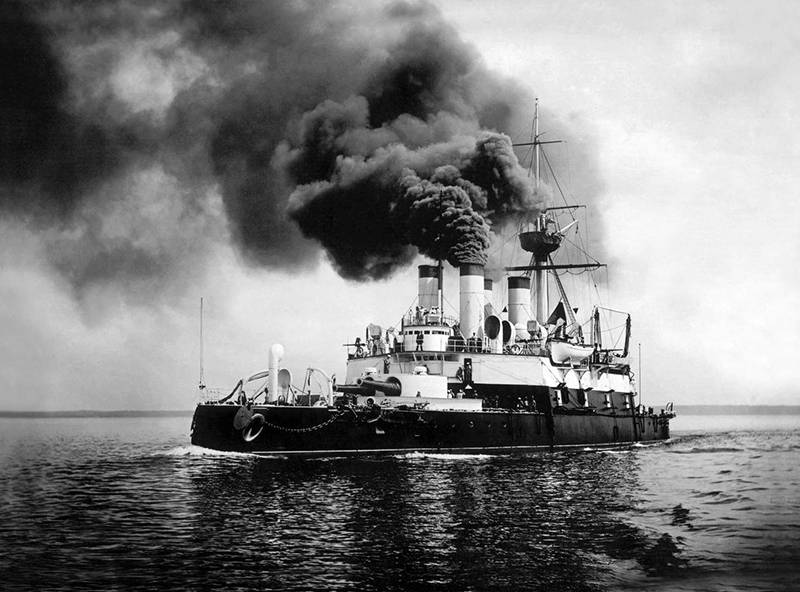
Soon, the project received the highest approval, and 1 July 1889, the new battleship was laid on the slipway after the launch of the Emperor Nicholas I launching. He was named "Navarin." The leading role in the design and construction of the “Navarin” was played by the famous Russian shipbuilder and inventor Peter Akindinovich Titov, who for several years had already headed the technical management of the Franco-Russian plant. The Vice-Admiral Nikolai Matveevich Chikhachev, the new manager of the Naval Ministry, was also no stranger to the introduction of various innovations - the most varied changes were made to the Navarin’s design already during construction. The rounded casemates were converted into rectangular ones, in order to become rounded again. The foremast of the battleship disappeared from the blueprints, then reappeared in a most surprising way. In the end, it is still left to use as a flagpole.
Big problems began when equipping the ship with armor — its main supplier and manufacturer, the Izhora plant, was critically disrupting delivery times. The technology for the manufacture of armor plates in that period was rapidly improved: iron iron armor was replaced by iron iron to be replaced in turn with steel-nickel. Each new technology required more advanced, sometimes qualitatively new equipment and newly trained specialists - all this required more time-consuming.
In October, 1891 was three months behind the Navarin. After began the routine and thorny procedure of completion. Suppliers delayed boilers and machinery, and it was difficult for domestic enterprises to manufacture the first closed caliber towers in the Russian fleet. At sea trials, it turned out that the battleship did not satisfy the requirements for ensuring floodability: the watertight bulkheads reached on it only to the residential deck. Only in the summer of 1896, five years after launching, Navarin was finally accepted into the treasury.
The ups and downs of the Black Sea project
In the Black Sea Fleet, meanwhile, the situation was as follows. In 1888, the original idea of building a second battleship of the “Twelve Apostles” type was abandoned. The fifth ship of this class, built for the Black Sea Fleet, was laid at the shipyard ROPiT in Sevastopol "George." In the absence of fundamentally new projects, it was decided to build on the type of "Catherine II". Many improvements have been made to the project, including new 35-caliber 305-mm main-caliber guns.
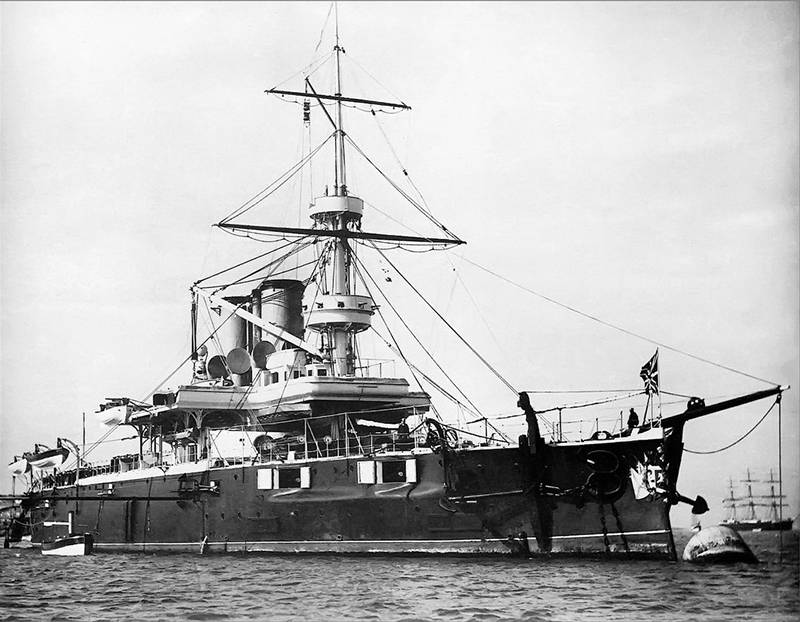
The construction of the “St. George the Victorious” began in the 1889 year, and the ship entered service in the middle of the 90s. What will be the sixth battleship for the Black Sea, the construction of which was planned in Nikolaevsky Admiralty, there was no single opinion - the new project after the Twelve Apostles simply did not exist.
The leadership of the Marine Ministry has changed, and with it the views on the development of the fleet and its priorities have been changed. In October, 1890, the Chief Commander of the Black Sea Fleet and Ports Vice Admiral Alexey Alekseevich Peshchurov addressed a report to the manager of the Marine Ministry. In it, the Vice-Admiral justified the need for the construction of a new type of battleship for the Black Sea Fleet.
The ships of the Catherine II type had a rather large draft reaching 8,5 meters with overload. This parameter somewhat hampered their main combat use against coastal fortifications and batteries. According to the Chief Commander of the Black Sea Fleet, the new battleship should have a draft of no more than 7,6 meters, but at the same time be no weaker than the "Twelve Apostles". For credibility, a draft of such a battleship, created by ship engineer Savery Ksaveryevich Ratnik, was attached to the report.
It is worth noting that, back in 1889, without waiting for fresh ideas from St. Petersburg, Vice-Admiral Peshchurov, as an initiative, ordered the Warrior to design a new battleship. The result was a sketch of a ship with a displacement of 9250 tons, armed with four 305-mm guns in two barbet installations. They were supplemented by ten 152-mm guns and the same 76-mm guns. The draft of the battleship was sustained within the limits specified by Peshchurovsky - 7,6 meters.
The Marine Technical Committee handed over the work of the Warrior to the scientific shipbuilder Erast Evgenievich Gulyaev, an authoritative figure in the naval circles at that time. Guliaev, having studied the project of the Black Sea battleship, made the following conclusions. The project had already outdated technical solutions, for example, the use of barbet installations and 305-mm guns of 30-, and not 35-caliber length. The mass of mechanisms and fuel was overestimated by reducing the mass of armor. The battleship of the battleship Warrior seemed to Gulyaev and other specialists from the Marine Technical Committee too elongated. His ratio of length to width was 5,35, while Navarina had 5,04.
As a result, the project of the Warrior was recognized as inferior to the Baltic Navarin, although it had a number of undoubtedly positive features, for example, conveniently located cars and boilers. The new Black Sea battleship was decided to build on the basis of the "Navarin", and the Marine Technical Committee immediately began to design work.
Squadron battleship "Three Saints"
The process of creating the project of the ship went quickly: in November 1890, it was approved by the Marine Technical Committee. The displacement of the battleship, not limited by the desire for "smallness", increased to 12500 tons - the largest figure in the domestic fleet. After a short time, the approved drawings were transferred to the General Directorate of Shipbuilding and Supplies for further construction orders.
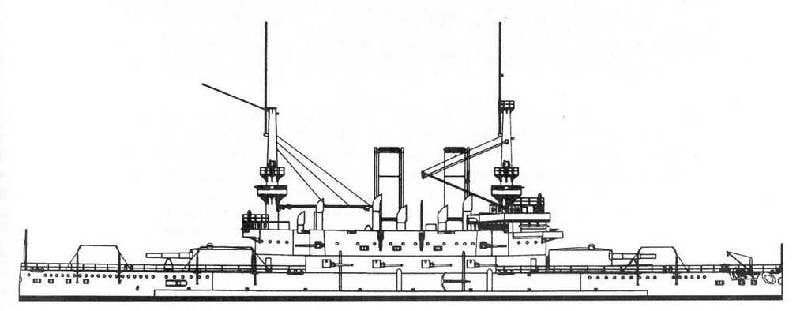
Vice-Admiral Nikolai Matveevich Chikhachev expressed the wish of the head of the Marine Ministry that the junior builder of the Nikolaev admiralty, Savery Ksaveryevich Ratnik, supervised the work in Nikolaev, with responsibility for the "Twelve Apostles" until the last one left for Sevastopol.
The construction of the sixth battleship of the Black Sea Fleet was planned in the Nikolaevsky Admiralty. Soon intensive work began on preparing the slipway No. XXUMX, the only place where ships of this class were built. The next offspring of the Nikolaev shipbuilders was supposed to have dimensions and displacement unprecedented for the Black Sea Fleet. Due to the large length of the hull of the future ship, the front wall of the slipway No.7 was disassembled, since the head part did not fit in it. In addition, it was necessary to lengthen the slipway - for this purpose, the workers hammered a large number of piles and made a laying appropriate for the size of the hull. August 7 The 2 of the year in the shed No.1891 has finally begun the hull works.
According to the approved project, the new battleship resembled the British ships of this class, the Trafalgar and the Nile. Their distinctive feature was a low, almost "monitor" board, the main caliber of 305-mm guns in the two towers. In the central armored two-tier casemate, the 152- and 120-mm rapid-fire guns were located.
The Black Seamen “Nile in Russian” seemed unacceptable - the frankly low board especially caused complaints. Around the already under construction armadillo with a new force boil the passion of design and technical nature. Warrior offered five options for improving the existing project to the Marine Technical Committee. The main idea was to remake a low-profile tower ship in a high-barreled barbet.
The “Barbet” party on the Black Sea Fleet turned out to be quite impressive: wide support for the proposals of the Warrior was rendered by the chief gunner of the Nikolaev port, Colonel L. I. Sanotsky, and even Grand Duke Alexander Mikhailovich. However, all these initiatives by the Marine Technical Committee were rejected, including such a sensible proposal as the replacement of hydraulic drives for turning the towers with electric ones.
The sixth Black Sea battleship was supposed to have a displacement of 12480 tons, the length between the extremities - 115,2 m, width along the mid-section - 22,7 m, average draft - 8,3 m. Impressive booking (3238 tons) was made of armor plates hardened by the method of Harvey. The thickness of the main belt reached a record for the Russian fleet indicator 457 mm. The thickness of the armor of the towers and the lower casemate was 406 mm. Since different types of armor were used on the ship — besides Harvey's, it was planned to have nickel-chromium — several manufacturers were assigned to make it: the French firms Schneider and Co in Creusot, the plant in Saint-Chamonix and the British firm Vikkers.
The battleship received four 305-mm 40-caliber guns with piston gates of Kane system as the main caliber. Eight 152-mm guns, also produced according to the French model, were located four on each side of the lower tier of the casemate. Four 120-mm guns were placed at the corners of the upper casemate. The armament was supplemented by ten 47-mm guns of the Hotchkiss system and numerous 37-mm guns.
At the beginning of August 1891, a contract was signed with the British firm Humphreys, Tannant and Co for the supply of boilers and machinery. Two three-cylinder steam engines had a rated capacity of 5300 l. with. each In four boiler rooms 14 cylindrical fire tube boilers were located. Such mechanisms were installed on the British battleships, for example, on the notoriously famous "Victoria". The flagship of the British Mediterranean squadron overturned and sank as a result of a ramming strike by the battleship Camperdown in 1897.
The capacity of the coal pits of the new ship made it possible to place 900 tons of coal there, which ensured the estimated cruising range in 2400 of miles with the 10 node node.
15 November 1891, the battleship was officially enrolled in the fleet lists under the name "Three Saints". From 1 February 1892, according to the accepted classification, the Three Saints became a squadron battleship. In the same month, at the request of the Chief Commander of the Black Sea Fleet about the timing of the official bookmark of the Three Hierarchs, the Maritime Ministry replied that it would be held in summer.
The corps of the new battleship gradually grew on the stocks. In the Nikolaev admiralty constantly came new materials and equipment for the ship under construction. The tiller and rudder stock were purchased from the German concern Krupp. The steering device came from England. The portholes made of aluminum steel, folding stanchions, set up the Lavrov factory in Gatchina.
4 September 1892 of the Three Saints was officially laid in the presence of Admiral General Grand Prince Alexander Mikhailovich, Chief of the Naval Ministry Admiral Chikhachev, Chief Commander of the Black Sea Fleet and Vice-Admiral Nikolai Vasilyevich Kopytov and other high-ranking authorities. The ship’s readiness at this point was 13%.
In July, the leadership of the work on the Three Saints passed on to 1893 to the senior shipbuilder of the port of Sevastopol, Alexander Ernestovich Shott. Savery Ksaverievich Warrior went to a new duty station in the capital. October 31 1893, the battleship was solemnly launched. Together with him passed the descent and mine cruiser "Griden".
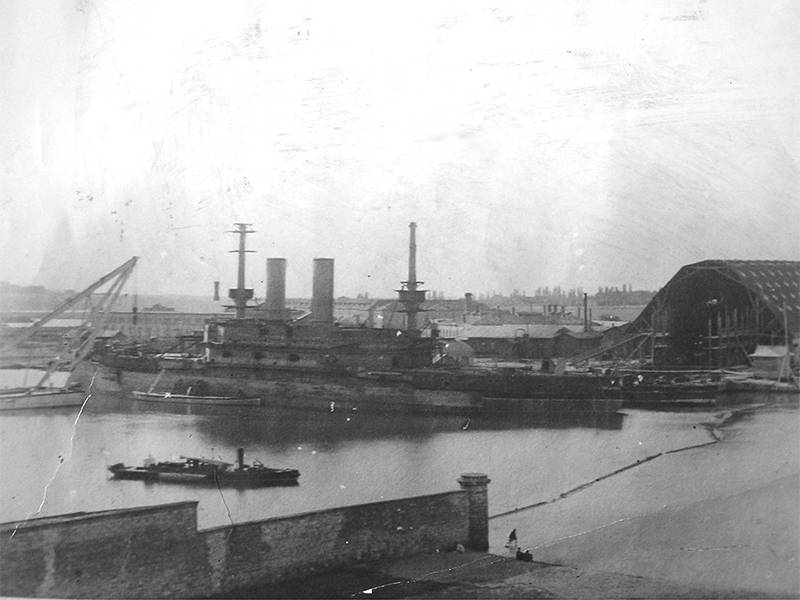
Began a long difficult period of completion afloat. Despite the tight deadlines stipulated in the contract and fines, the supply of equipment was disrupted and delayed. Many issues, down to the smallest detail, had to be coordinated with the Marine Technical Committee. With the then means of communication, it was troublesome, costly and very long. So, in September, 1894 from the Maritime Technical Committee sought an urgent answer to the crucial question: how to upholster furniture in the mess room: with wool reps or morocco?
The drawings were constantly corrected and supplemented, and in St. Petersburg often they did not have time to approve. For example, in August 1895, after two years after launching, the builder could not ventilate the ship due to the absence of blueprints on it. And only in November 1894 of the year, when the Three Prelates were transferred for further completion from Nikolaev to Sevastopol, the Marine Technical Committee decided on the type of conning tower, to begin, finally, to make armor for it.
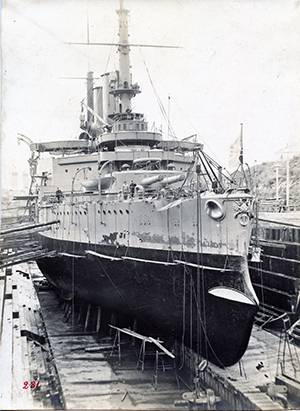
In November, the first tests began on 1896. English-made machines have developed power 11300 l. with. instead of calculated 10600 l. with. Due to this, “Three Saints” developed speed in 16,5 nodes, which was the best indicator among the battleships of the Black Sea Fleet.
The ship entered service at the end of the 1896 of the year, after conducting a series of successful shooting and tests. At this point, the Three Saints was considered the strongest battleship of the Black Sea Fleet and the entire Russian Fleet. However, the ship had a number of deficiencies, which were corrected without much haste. Even at the beginning of 1901, the fleet command determined the list of additional work on the ship at the 32 point. The large displacement reserve allowed the Three Saints to be upgraded in 1910 – 1911, and, reclassified into a battleship, he took an active part in the First World War.
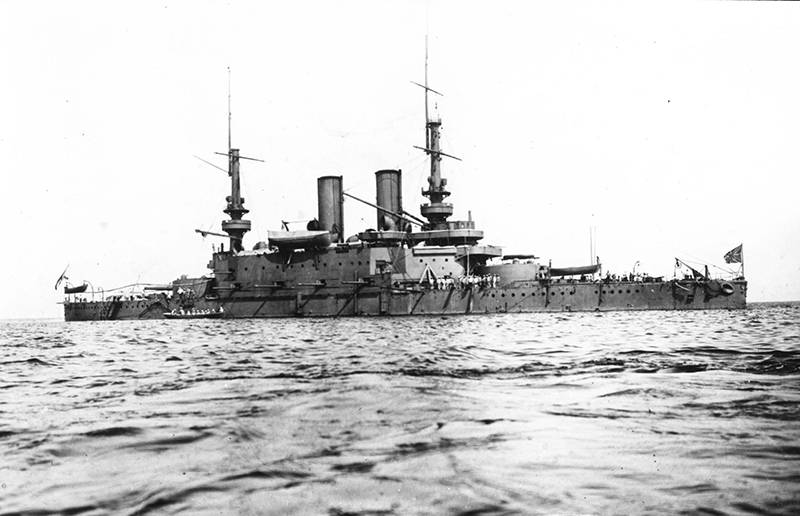
In 1918, it was deposited at the port, and in 1920, it was dismantled for metal. AT stories domestic shipbuilding and the Nikolaev admiralty battleship "Three Saints" played an important role. The construction of battleships of the classical type with closed turrets of the main caliber located on the ends, finally replacing the outdated barbet installations, began on the Black Sea Fleet.
To be continued ...
Information